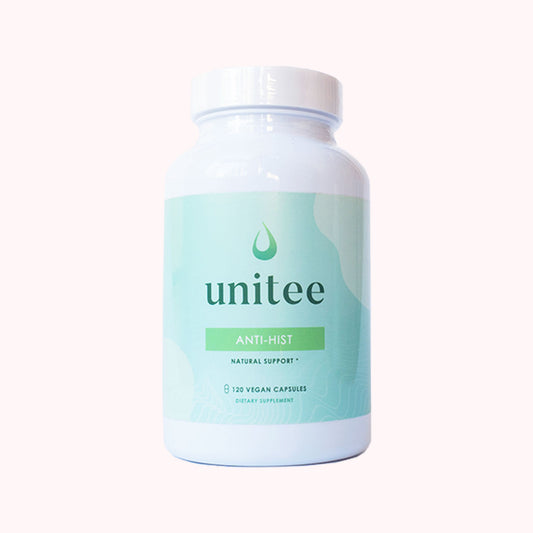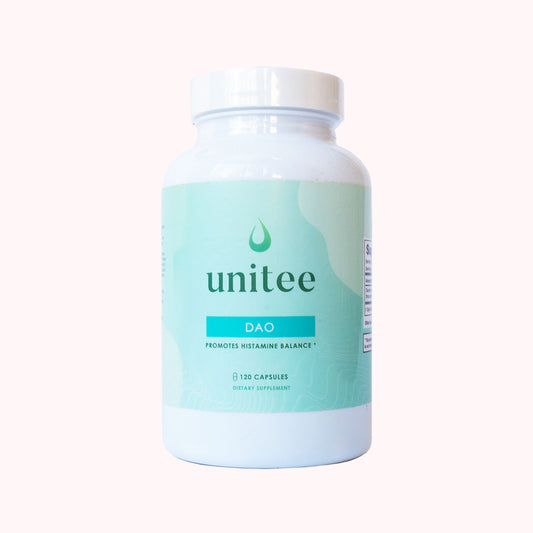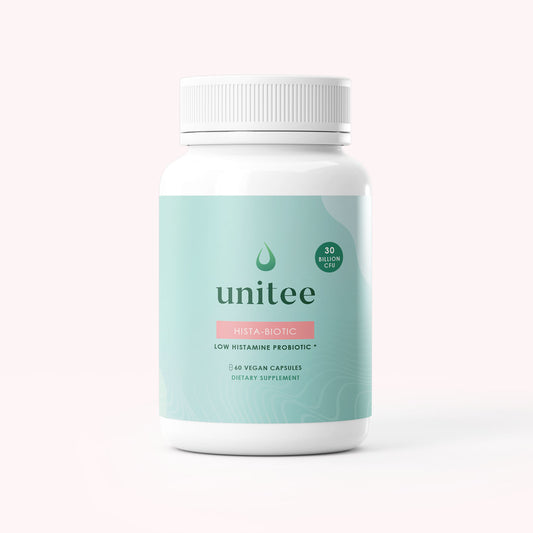There are few things that are worse than bloating. A swollen and full belly not only feels really uncomfortable, it can really ruin your day.
You feel like your clothes don’t fit right. You can’t stand or sit, or even lie down without being fully aware of the balloon in your stomach. You may also worry that you need to be close to a restroom or stay away from other people in case there’s an accident…
We know how many of you deal with this on a regular basis. Why? Because bloating is one of the most common symptoms of histamine intolerance.
Is Bloating a Symptom of Histamine Intolerance?
We see it in clinical clients all the time. On almost every health intake sheet is written the word: bloating.
There’s also a great research article that was published by the Intestinal Research Journal to support the common occurrence of this symptom (1). They wanted to know, just like we do, what could be going on.
As you know, there is a wide variety of histamine intolerance symptoms that can impact many systems across your entire body - however, there are a number of symptoms that commonly occur which are specific to the digestive system itself.
As part of the study, the researchers recruited 133 patients who had been suffering from a range of these symptoms for a number of months. While the feeling of fullness after meals, diarrhea, pain in the abdomen and constipation were all high up on the list of common symptoms experienced by most of the participants, it was bloating that really stood out. On top of that, those who reported that they had bloating, said that it was one of the most chronic and persistent symptoms they had.
What is it about histamine intolerance that could leave you with a swollen and painful belly day in and day out?
Let’s recap the effects that histamine can have on the digestive tract to find out…
Bloating and Gut Microbiome Imbalance Leading to Histamine Intolerance
In many of our clients, we can detect histamine releasing bacteria in their stool samples that are sent to the lab for testing. One of the most common is the Klebsiella Pneumoniae species, which has been tied to bloating in a range of different studies. When these little critters take over the environment of the gut, nothing good comes of it.
You’re supposed to have a wide variety of bacteria living in your colon. The more there are, the less they compete with each other for nutrients, and they also share their real estate with others, working towards the health of the colonic environment.
As you can imagine, anything that reduces the number of good bacteria in your system gives the less helpful types the opportunity to take over. Klebsiella (2) is one of those species that takes the chance when it’s presented.
Klebsiella is usually found in the digestive tract. They play a role in the digestion of carbohydrates such as lactose, fructose and mannose, and even in the digestion of resistant starches and prebiotic fibers, like inulin. It doesn’t cause much distress, because it’s a part of normal digestion.
Now, imagine you had a course of antibiotics, or a bout of food poisoning. Either of these could have caused a decline in the good, healthy bacteria in your gut.
As a result, Klebsiella, and possibly a couple of other more bothersome types, will keep going - they’re a little more hardy in these tough environments and can survive the onslaught. As they begin to realize they’re not being managed by the healthy bacteria anymore, they thrive. They begin to feed on more and more of the nutrients presented to them, and they grow in strength and number.
In doing so, they feast on all of these carbs and starches that aren’t being digested normally any more. Essentially, when they become unruly, they eat more and more, and it’s their consumption of these carbs and starches that are associated with the release of compounds that cause gas. That’s when the bloating sets in (3).
In some individuals, this can be a transient issue - however, over time, this issue may develop into more serious and chronic issues such as irritable bowel syndrome (IBS) or small intestinal bacterial overgrowth (SIBO).
Another problem that presents itself here is the growing resistance to antibiotics. You may find that you have an infection, so the first thing that you may think to take is another course of antibiotics, but the trouble is, it can help the klebsiella to grow even stronger (4).
So what do you do instead?
Beating Histamine Intolerance by Improving Gut Health and Bloating
The main area to focus on when you’re struggling with bloating and other non-specific gut symptoms is to regain balance of your gut bacteria. There are two ways to do so:
By adding more healthy bacteria back into your gut environment, you create the opportunity for healthy bacteria to come back into play, modulating the action of the klebsiella.
Remember you need to be cautious of the types of bacteria you’re using, as there are numerous common species that are considered healthy probiotics which may also release histamines. That’s why we have a specific low histamine probiotic formula to help you on your way. This probiotic formula is made specifically for those with histamine intolerance to regain gut balance without adding any bacteria that can worsen histamine symptoms.
You can also consider taking the friendly yeast, called S. boulardii, alongside the probiotics, which may help especially after taking antibiotics and in the cases where you have diarrhea along with the bloating (5).
Note that if you’re particularly sensitive, you’ll want to start slowly with both of these products. There is no harm in starting with half the bottle dosage if you want to give your body time to adjust, and this adjustment period usually only lasts a short time.
In the short term, removing some of the food that is feeding the bothersome bacteria may help to relieve the symptoms. We mentioned carbs and resistant starches, so these should be decreased in the diet to help with the gas formation as well as helping to reduce the strength that these bacteria have to thrive. For a short period of time, stop eating all forms of sugars, grains, starchy carbs and high glycaemic index fruit. You’ll quickly know if this is one of the reasons you’ve had the bloating in the first place.
This bacterial regulation is also one of the reasons our low histamine diet limits these types of carbohydrates. Click below to get our free low histamine diet guide which tells you exactly what to eat and avoid as well as the type and amount of carbohydrates to consume daily for gut regulation:
Be sure to do work with your doctor or dietitian to ensure that you’re still getting a good range of different foods in your diet, in order to ensure you get the full range of nutrients!
There is another source of help, and that comes in the form of diamine oxidase (DAO) enzymes. DAO enzymes can help to reduce the effect that histamines may be having on your body. Interestingly, DAO enzymes are specifically responsible for degrading ingested histamine.
What this means is that DAO enzymes have a particular role of reducing histamine impacts within the digestive system.
Although the reduction in histamine levels also improves histamine-associated symptoms in the rest of the body, the intestinal action is why DAO enzymes become of particular interest to those experiencing digestive issues.
DAO enzyme supplements, in particular, offer an option to provide short term relief from your histamine intolerance symptoms, both those that occur in the digestive system, and overall (6).
The Next Steps In Your Healing Histamine Journey...
Bloating can be a really frustrating symptom and greatly affect your everyday quality of life. Although some healthcare practitioners may be quick to downplay the severity of this symptom, I do understand that it can have a huge impact on your overall well being causing significant physical and mental discomfort.
If you're still not sure where to start, be sure to get our free diet guide - you can try it for 2 weeks and see if your symptoms improve, which can be a great indicator that you need to do some work on histamine intolerance, the gut and bloating in general.
If you're further down the journey already and are aware that you have histamine issues alongside gut issues, it's a great option to explore some of the alternative therapies we have discussed above.
Supplements can be a great option for moving the needle on digestive conditions, so trying out a low histamine probiotic and a DAO enzyme supplement can be a great next step!
I hope this helps you to get to the bottom of what could be causing your bloating, and help to ease the pain and discomfort!
References:
- Schnedl WJ, Lackner S, Enko D, Schenk M, Holasek SJ, Mangge H. Evaluation of symptoms and symptom combinations in histamine intolerance. Intest Res. 2019;17(3):427-433.
- Ganji L, Alebouyeh M, Shirazi MH, et al. Dysbiosis of fecal microbiota and high frequency of Citrobacter, Klebsiella spp., and Actinomycetes in patients with irritable bowel syndrome and gastroenteritis. Gastroenterol Hepatol Bed Bench. 2016;9(4):325-330.
- Zhang Q, Su X, Zhang C, et al. Klebsiella pneumoniae Induces Inflammatory Bowel Disease Through Caspase-11-Mediated IL18 in the Gut Epithelial Cells. Cell Mol Gastroenterol Hepatol. 2023;15(3):613-632. doi:10.1016/j.jcmgh.2022.11.005
- Setiawan A, Widodo ADW, Endraswari PD. Comparison of ciprofloxacin, cotrimoxazole, and doxycycline on Klebsiella pneumoniae: Time-kill curve analysis. Ann Med Surg (Lond). 2022;84:104841. Published 2022 Nov 5. doi:10.1016/j.amsu.2022.104841
- Kelesidis T, Pothoulakis C. Efficacy and safety of the probiotic Saccharomyces boulardii for the prevention and therapy of gastrointestinal disorders. Therap Adv Gastroenterol. 2012;5(2):111-125. doi:10.1177/1756283X11428502
- Schnedl WJ, Schenk M, Lackner S, Enko D, Mangge H, Forster F. Diamine oxidase supplementation improves symptoms in patients with histamine intolerance. Food Sci Biotechnol. 2019;28(6):1779-1784. Published 2019 May 24. doi:10.1007/s10068-019-00627-3

Anita Tee
My name is Anita Tee. I'm a nutritional scientist specializing in histamine intolerance. I hold a Master of Science in Personalized Nutrition and a Bachelor of Science in Human Biology and Psychology. For the past ten years, I have used my experience in nutritional and medical health sciences to create a scientifically backed, natural approach to healthcare that relies 100% on evidence-based research. As I previously suffered from - and overcame - histamine intolerance, my focus is to increase recognition and expand the available resources and protocols available for resolving this particular disorder. To date, I have helped over 4,000 individuals fully resolve or better manage their histamine intolerance symptoms.







